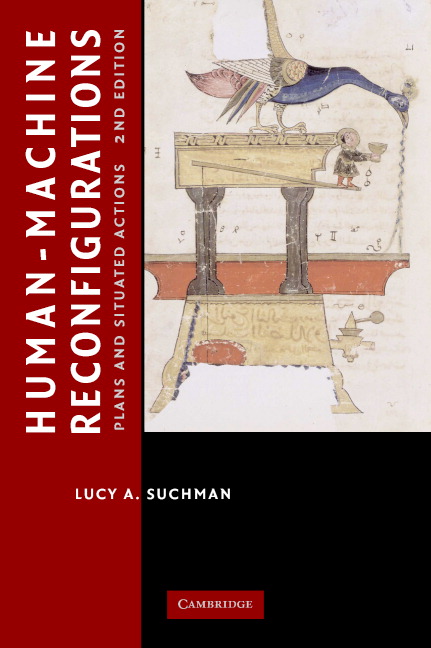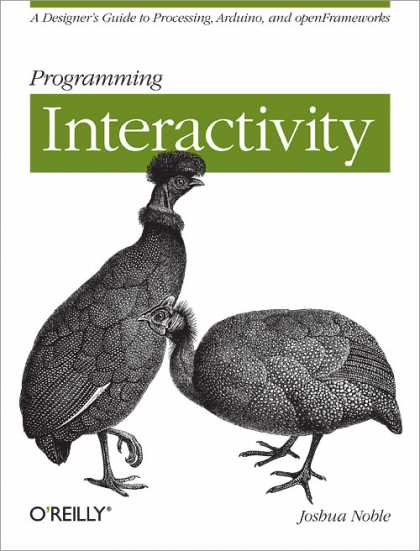Lucy Suchman: Human-Machine Reconfigurations: Plans and Situated Actions, 2nd ed (2007)
Filed under book | Tags: · anthropology, artificial intelligence, cognitive science, computing, ethnomethodology, human-computer interaction, interface, machine, robots, software, technology

“This 2007 book considers how agencies are currently figured at the human-machine interface, and how they might be imaginatively and materially reconfigured. Contrary to the apparent enlivening of objects promised by the sciences of the artificial, the author proposes that the rhetorics and practices of those sciences work to obscure the performative nature of both persons and things. The question then shifts from debates over the status of human-like machines, to that of how humans and machines are enacted as similar or different in practice, and with what theoretical, practical and political consequences. Drawing on scholarship across the social sciences, humanities and computing, the author argues for research aimed at tracing the differences within specific sociomaterial arrangements without resorting to essentialist divides. This requires expanding our unit of analysis, while recognizing the inevitable cuts or boundaries through which technological systems are constituted.”
Publisher Cambridge University Press, 2007
Learning in Doing: Social, Cognitive and Computational Perspectives series
ISBN 052167588X, 9780521675888
314 pages
Joshua Noble: Programming Interactivity: A Designer’s Guide to Processing, Arduino, and OpenFrameworks (2009)
Filed under manual | Tags: · arduino, human-computer interaction, interactivity, physical computing, processing

If you’re interested in using electronics and programming to create rich interactive experiences with your artwork, designs, or prototypes, “Programming Interactivity” is the place to start. You’ll explore common themes in interactive art and design, like 2D and 3D graphics, sound, physical interaction, computer vision, circuit bending, geo-location and more. This book explains programming and electrical engineering basics, and introduces three freely available tools created specifically for artists and designers:
- Processing, a Java-based programming language and environment for building projects on the desktop, Web, or mobile phones
- Arduino, a system that integrates a microcomputer prototyping board, IDE, and programming language for creating your own hardware and controls
- OpenFrameworks, a coding framework simplified for designers and artists, using the powerful C++ programming language
You’ll get working code samples you can use right away, along with the background and technical information you need to design, program, build, and troubleshoot your own projects. “Programming Interactivity” also examines cutting-edge design techniques, and includes discussions with leading artists and designers on projects and theory.
Publisher O’Reilly Media, Inc., 2009
ISBN 0596154143, 9780596154141
Length 768 pages
more info (gbooks)
programminginteractivity.com
preview
Susan Kozel: Closer: Performance, Technologies, Phenomenology (2007)
Filed under book | Tags: · body, dance, human-computer interaction, performance, phenomenology, philosophy, technology, telematics, wearable computing

“In Closer, Susan Kozel draws on live performance practice, digital technologies, and the philosophical approach of phenomenology. Trained in dance and philosophy, Kozel places the human body at the center of explorations of interactive interfaces, responsive systems, and affective computing, asking what can be discovered as we become closer to our computers—as they become extensions of our ways of thinking, moving, and touching.
Performance, Kozel argues, can act as a catalyst for understanding wider social and cultural uses of digital technology. Taking this one step further, performative acts of sharing the body through our digital devices foster a collaborative construction of new physical states, levels of conscious awareness, and even ethics. We reencounter ourselves and others through our interactive computer systems. What we need now are conceptual and methodological frameworks to reflect this.
Kozel offers a timely reworking of the phenomenology of French philosopher Maurice Merleau-Ponty. This method, based on a respect for lived experience, begins by listening to the senses and noting insights that arrive in the midst of dance, or quite simply in the midst of life. The combination of performance and phenomenology offered by Closer yields entwinements between experience and reflection that shed light on, problematize, or restructure scholarly approaches to human bodies using digital technologies.
After outlining her approach and methodology and clarifying the key concepts of performance, technologies, and virtuality, Kozel applies phenomenological method to the experience of designing and performing in a range of computational systems: telematics, motion capture, responsive architectures, and wearable computing.
The transformative potential of the alchemy between bodies and technologies is the foundation of Closer. With careful design, future generations of responsive systems and mobile devices can expand our social, physical, and emotional exchanges.”
Publisher MIT Press, 2007
Designer: Rebeca Méndez
ISBN 0262113104, 9780262113106
355 pages
PDF (updated 2016-5-4)
Comments (2)
